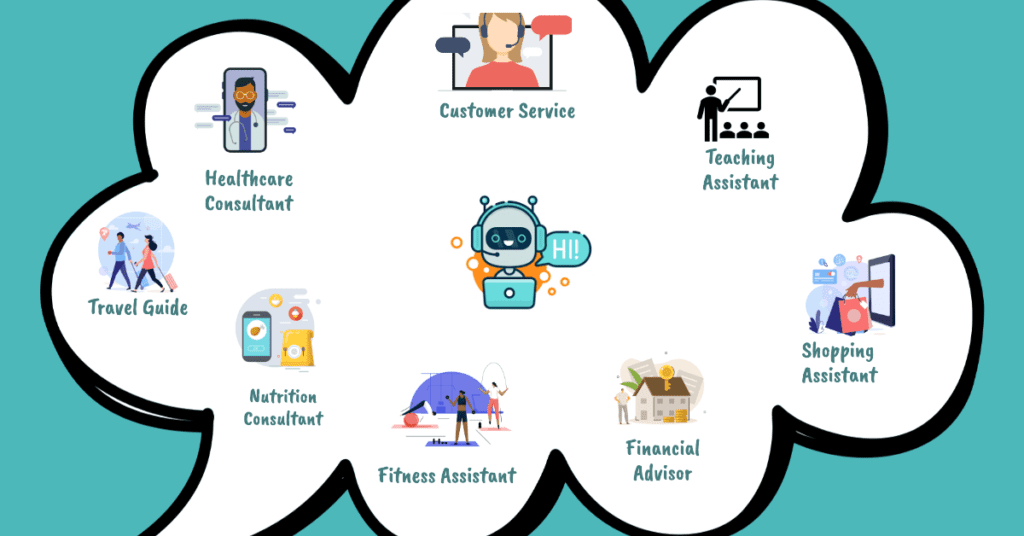AI Chatbots: Discover how to reap its benefits

AI chatbots are transforming how businesses interact with customers, delivering automation, personalization, and efficiency. From e-commerce to healthcare, industries across the board are adopting this technology at an unprecedented rate. With the AI chatbot market growing rapidly, understanding its current landscape, challenges, and opportunities is essential for businesses and developers looking to capitalize on this technology. Madgical has been specialising in building state-of-the art AI Chatbots since 2022. Please checkout our portfolio for more details. In this blog, we will explore the trends, challenges, and opportunities in the AI chatbot market, with an emphasis on statistical insights, key players, and market dynamics.
1. Introduction

The rise of AI chatbots has revolutionized how businesses engage with their customers. Today, chatbots are no longer limited to handling basic queries; they have evolved into sophisticated systems capable of managing complex conversations, providing real-time insights, and integrating with a wide array of business systems. The global AI chatbot market was valued at $5.5 billion in 2023 and is projected to reach $15.5 billion by 2028, growing at a CAGR of 23.3% during the forecast period. This staggering growth is being fueled by increasing demand for automation and efficient customer service solutions.
With businesses across industries leveraging AI chatbots, they are becoming essential tools for improving customer experience and driving sales. The ability to provide instant, 24/7 responses and personalized services is reshaping customer expectations, and companies that adopt chatbots are gaining a significant competitive edge.
2. Current Trends in AI Chatbots
The demand for AI chatbots has surged as businesses recognize their potential to automate processes and enhance customer interactions. Several trends are shaping the future of AI chatbots:
Automation and Efficiency
AI chatbots are in high demand for automating routine tasks, especially in customer service. In fact, 69% of consumers prefer chatbots for instant communication with brands. By automating repetitive tasks such as answering FAQs, processing orders, or resolving simple issues, chatbots allow businesses to reduce operational costs while improving response times.
A key trend is the adoption of 24/7 availability chatbots, which offer round-the-clock customer service. These bots can handle large volumes of inquiries, reducing the need for human agents and ensuring customers receive immediate responses.
Data-Driven Insights
Another trend is the integration of AI chatbots as data collection tools. By analyzing customer interactions, businesses can gather real-time feedback and generate valuable insights into customer preferences and behaviors. 80% of companies are already using chatbots to collect data that helps shape their marketing strategies and improve service quality.
Real-time analytics powered by chatbot data help businesses refine their products and services, providing a data-driven approach to customer engagement.
AI Chatbots in E-commerce
E-commerce is one of the industries benefiting most from AI chatbots. Conversational commerce, which allows customers to make purchases directly through chatbot interactions, is becoming a significant driver of sales. In 2023, 35% of consumers used chatbots to make online purchases. By providing personalized shopping recommendations and guiding customers through the purchasing process, chatbots increase sales conversions and enhance the overall shopping experience.
3. Challenges in Implementing AI Chatbots
While the potential of AI chatbots is vast, but it also possesses various challenges, such as integration with legacy systems, users privacy and bot infrastructure maintenance cost.
Integration with Business Systems
One of the major challenges is integrating chatbots with existing business systems such as CRM and ERP platforms. 37% of businesses report difficulties in integrating AI chatbots with their legacy systems, which can hinder the chatbot’s ability to deliver personalized and accurate responses. Seamless integration is critical to ensuring that chatbots can access relevant customer data and provide meaningful interactions.
Balancing chatbot automation with human intervention is another challenge. Customers still expect human support for complex issues, and businesses must ensure a smooth handoff between chatbots and human agents.
User Adoption and Trust
Building trust with customers is essential for successful chatbot adoption. 55% of consumers are still wary of sharing sensitive information with chatbots, and poor user experiences with chatbots can lead to frustration. Ensuring smooth and accurate interactions is key to fostering user trust and increasing adoption rates.
Cost vs. Benefit Analysis
Implementing AI chatbots requires significant investment. The average cost of maintaining an AI chatbot infrastructure ranges from $20,000 to $80,000 per year, depending on complexity, customization, and scalability. Businesses must conduct a thorough cost-benefit analysis to ensure that chatbot deployment leads to positive ROI. While chatbots can reduce labor costs and increase efficiency, upfront development and integration expenses are substantial.
4. Opportunities for Businesses
The growing AI chatbot market presents numerous opportunities for businesses looking to enhance their services and drive growth.
Scaling Customer Support
AI chatbots provide a scalable solution for customer support. Businesses can reduce the need for large customer service teams by automating routine inquiries, allowing agents to focus on complex cases. This leads to improved efficiency and reduced labor costs, with cost savings up to 30% reported by businesses that implement chatbots.
Enhancing Marketing Strategies
Chatbots are also revolutionizing personalized marketing. By analyzing customer conversations, businesses can launch targeted campaigns based on customer preferences, increasing engagement and conversion rates. In fact, 47% of consumers are more likely to make a purchase from a chatbot after receiving personalized recommendations.
New Revenue Streams and Global Expansion
Chatbots offer new revenue streams through conversational commerce and subscription-based services. As businesses expand globally, chatbots with multilingual capabilities enable them to provide support across different regions and languages, helping them enter new markets.
5. Major Players in the AI Chatbots Market
Several companies are leading the charge in AI chatbot development, providing innovative solutions that set the standard in the market. Some of the major players include:
- Google Dialogflow: Offering a powerful platform for building conversational interfaces.
- IBM Watson: A leader in AI-driven solutions, including advanced chatbot capabilities.
- Microsoft Bot Framework: One of the most widely used platforms for building and deploying chatbots.
- Amazon Lex: Known for its integration with AWS and use of natural language processing to build bots.
- Zendesk Chat: A customer service-oriented chatbot solution for businesses of all sizes.
These companies are constantly innovating, providing tools that make chatbot development and deployment more accessible and efficient.
6. Gaps and Opportunities in the AI Chatbots Market
Despite the rapid growth of AI chatbots, there are still significant gaps and opportunities for further innovation.
Gaps:
- Natural Language Understanding: While chatbot technology has made great strides, there are still gaps in natural language understanding (NLU). Chatbots sometimes struggle with interpreting complex or ambiguous customer requests, leading to poor user experiences.
- Personalization: Chatbots need to further improve personalization by leveraging more in-depth customer data and contextual awareness.
Opportunities:
- Industry-Specific Solutions: There is an increasing demand for industry-specific chatbot solutions, such as healthcare bots capable of patient triage or finance bots that provide investment advice.
- Advanced AI Features: AI advancements such as sentiment analysis, voice recognition, and emotional intelligence represent untapped potential for more sophisticated and responsive chatbots.
7. Key Aspects for a Profitable Chatbot Development Business
AI Chatbots integration could be a huge bet to make next level profitable business. For businesses looking to profit from chatbot development, the following key aspects should be considered:
- Customizable Solutions: Offering customizable chatbot solutions tailored to specific business needs can set you apart in the market.
- Scalability: Ensure your chatbot platform can scale easily to meet the growing demands of clients.
- Continuous Improvement: Regular updates, feature enhancements, and customer feedback loops are essential to maintaining a competitive edge.
- Industry Expertise: Specializing in industries like healthcare, finance, or retail can help differentiate your services and attract clients looking for tailored solutions.
8. Key Research Areas in AI Chatbots
As the AI chatbot market matures, several research areas are emerging that will shape its future:
- Emotional Intelligence: Developing chatbots that can understand and respond to human emotions in real-time interactions.
- Multimodal Interactions: Combining text, voice, and visual inputs to create more intuitive and engaging chatbot experiences.
- Ethics and Bias: Addressing ethical concerns and bias in chatbot algorithms to ensure fair and unbiased interactions.
- Autonomous Learning: Chatbots that can self-learn from interactions without requiring manual reprogramming.
These research areas represent the next frontier in chatbot development and will drive the future of AI chatbot technology.
Conclusion
AI chatbots are transforming businesses by automating tasks, improving customer engagement, and driving sales. With the global chatbot market growing at an impressive rate, the opportunities for businesses to scale, innovate, and expand are vast. However, businesses must navigate integration challenges, user adoption, and cost considerations to realize the full potential of chatbot technology. As the market continues to evolve, those who invest in AI chatbots will be well-positioned to reap the rewards of this transformative technology.
References
- How to Achieve 60% AWS Cost Optimization with Functions and Tags
- How to Optimize QA Automation for 30% Quicker Releases
- 30% Time Savings in AI Development: The EKS CI/CD Solution
- How to Get Started with Terraform: A Step-by-Step Guide
Follow US
Disclaimer
The views are those of the author and are not necessarily endorsed by Madgical Techdom.